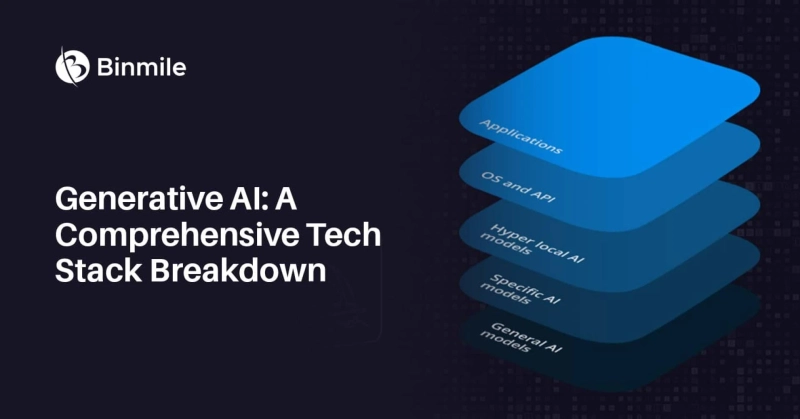In the ever-evolving landscape of software development and app creation, Generative Artificial Intelligence (AI) stands out as a revolutionary force, transforming the way we approach creativity and innovation.
This guide delves into the intricate tech stack that underpins Generative AI, exploring the journey from neural networks to frameworks, and how this technology is reshaping the realm of software and app development.
Understanding Generative AI:
Generative AI refers to a subset of artificial intelligence that involves machines creating content, often with a level of autonomy and creativity. This technology encompasses a range of applications, from generating realistic images and videos to composing music and even crafting written content.
Neural Networks as Building Blocks:
At the heart of Generative AI are neural networks, computational systems inspired by the human brain\'s interconnected neurons. Neural networks consist of layers of interconnected nodes, each node simulating a neuron. These networks are trained on massive datasets to learn patterns, enabling them to generate new content that aligns with the learned patterns.
- Encoder-Decoder Architectures:
Many Generative AI models utilize encoder-decoder architectures. Encoders process input data and extract relevant features, while decoders use these features to generate output. Variational Autoencoders (VAEs) are a prime example, transforming data into a compressed format and then generating new content based on this encoding. - Generative Adversarial Networks (GANs):
GANs introduce a novel concept: two neural networks, the generator and the discriminator, engage in a competitive learning process. The generator creates content, and the discriminator evaluates its authenticity. This iterative process refines the generator\'s output until it can generate content indistinguishable from real data.
Frameworks Enabling Innovation:
While the concepts behind Generative AI are fascinating, the practical implementation involves complex computations and significant data manipulation. This is where frameworks play a vital role. Frameworks provide pre-built tools and libraries that streamline the development process, making it accessible to developers without requiring them to reinvent the wheel.
- TensorFlow:
Developed by Google, TensorFlow is a popular open-source framework used for a range of AI applications, including Generative AI. Its versatility, scalability, and support for deep learning architectures make it a favorite among developers. - PyTorch:
PyTorch, developed by Facebook\'s AI Research lab, is another widely adopted framework. Its dynamic computation graph and user-friendly interface have made it a favorite for research and rapid prototyping in Generative AI. - Keras:
Keras is known for its simplicity and ease of use, making it an excellent choice for those new to Generative AI. It offers a high-level interface to create and train neural networks, and it can run on top of TensorFlow or other frameworks.
Application in Software and App Development:
- Art Generation:
Generative AI has brought art creation to new heights. AI-powered algorithms can create stunning visual art, from paintings to sculptures, opening up novel ways for artists to express themselves. - Content Generation:
Content generation is a domain that Generative AI has significantly impacted. Whether it\'s generating realistic human faces for avatars, composing written content, or crafting code snippets, the possibilities are vast. - Design and Creativity:
Generative AI is transforming design processes. From creating unique logo designs to generating intricate patterns and textures, AI offers designers a wellspring of inspiration. - Gaming and Virtual Worlds:
In the gaming realm, Generative AI breathes life into virtual worlds. Procedural content generation allows developers to create vast, diverse, and immersive game environments.
Challenges and Ethical Considerations:
While Generative AI holds immense promise, it\'s not without its challenges. Ensuring generated content is ethical and unbiased remains a concern. Models trained on biased data can perpetuate stereotypes or produce inappropriate content. Striking a balance between creative autonomy and responsible content generation is a pressing challenge.
Conclusion: Pioneering Creativity with Generative AI\'s Tech Stack
Generative AI\'s journey from neural networks to frameworks has unlocked a new era of creativity and innovation. As software and app developers, leveraging Generative AI tech stack capabilities offers a realm of possibilities, from artistic endeavors to content creation and beyond.
The tech stack behind Generative AI, combined with the power of frameworks, has democratized access to this groundbreaking technology. However, as we harness its potential, ethical considerations and responsible use remain paramount. Generative AI stands as a testament to the symbiotic relationship between technological advancement and human creativity, reshaping the landscape of software development services and mobile app development in profound ways.



